![]()
![]()
![]()
Use LEFT and RIGHT arrow keys to navigate between flashcards;
Use UP and DOWN arrow keys to flip the card;
H to show hint;
A reads text to speech;
16 Cards in this Set
- Front
- Back
|
Pleurodira
|
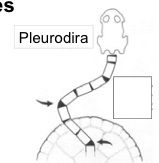
*side-necked turtles
*southern hemisphere *dominant freshwater spp in australia *fold neck to side under shell for protection |
|
|
Cryptodira
|

*neck folds in mid-sagittal plane in head retraction
*sea turtles, freshwater turtles, land tortises |
|
|
Australian Cryptodira
|
no land tortises in Australia
Pig-nosed turtle- only freshwater spp 6 sea turtles green, loggerhead, hawksbill, leatherback, Pacific ridley |
|
|
Pig-nosed turtle
|
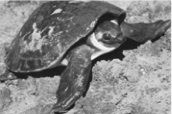
Carettochelys insculpta
Recent arrival from Papua New Guinea Lives in streams in wet-dry tropics Builds nest and lays eggs during dry season Nest in sand banks on edge of rivers Embryos aestivate inside eggshell at the end of incubation and explosively hatch when sand bank is flooded Omnivorous- fruit and seeds. ribbon weed and other aquatic plants Sex determined by incubation temperature |
|
|
Australian Pleurodira Turtles
|
Ancient gondwana origion- affliliated w/ Samerica spp
~25spp recognized 7 long necked spp- genus Chelodina 18 short necked spp 4 Elseya lastiternum 5 Elseya dentata 5 Emydura species 1 Pseudemydura 1 Elusor spp 1 Rheodytes All are carnivores as hatchlings Opputrunistic omnivores as adults Chelodina-predators Elseya- herbivores all spp- GENETIC SEX determination clutch- 10 to 30 all females larger NOT western swap and Mary River turtle |
|
|
Incubation Strategies of Australian Pleurodira Turtles
|
Nest after rain during breeding season
Temperate climate spp- nest furing spring/summer Wet/dry tropics- nest during dry season |
|
|
Genus Emydura
|
most numerous group along east coast of australia
medium sized- 2-3kg, 25-35cm Swamps, lakes rivers creeks Oppurtunistic, thrive in tertiary waste treatment ponds Spring/summer nester |
|
|
Brisbane River Turtle
|
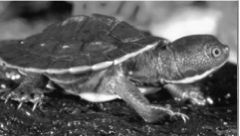
Emydura signata
Most common spp in Uni lakes Frequently basks -thermoregulatory? -anti microbial? -vitamin D? Spring sumer nester Can have more than 1 clutch in a breeding season 8-31 eggs, 5-11g two dif females, same clutch mass but package eggs diff 10/10g eggs vs 50x5g eggs |
|
|
Western Swamp turte
|
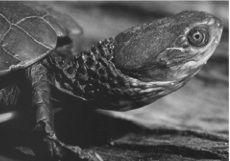
Pseudoemydura umbrina
RAREST turtle 100 living speciments in 200ha wetland near perth wetland-dry a lot: aestivate and carniverous Females dig nest with front feet in Zoo- ~15cm *Australia's RAREST TURTLE |
|
|
Fitzroy river turtle
|
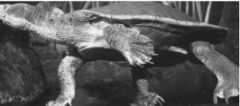
Rheodytes leukops
Fitzroy river catchment *well developed cloacal bursae--> gill, get o2 from water 'bum breather' In well oxygenated water ways can dive 6-8 hrs Colaca is ventilated- accnt 50% O2 in moderate activinty and 100% in low activity Large surface area and capilaries close to surface *Distinctive WHITE EYES * feeds on invertabrates, esp insect larvae found in shallow water ripple zones btwn pools at night |
|
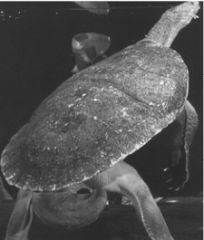
Mary River Turtle
|

*Mary River catchment
*large, 5-7kg 30-4-cm *large tail laterally compressed *Cloacal ventilator (bum breather) *Omniverous, ribbon weed, bivalve mollusks *spring/summer nester *Males LARGER than females |
|
|
saw-shelled snapping turtles
|

*Genus Elseya
*Larger spp are herbivorous as adults *bum breathers |
|
|
Southern Snapping turtle
|
Elseya albagula
*from mary and Burnetter river catchmeny *large females 5-8kg LARGER than males 3-5 kg *Herbiverous as adults, ribbon weed, grass, roots, fruits and flowers *bum breathers *nests autum/winter eggs diapause at early stage *heavy nest predation |
|
|
Genus Chelodina
|
Long necked turtles
7spp highly carniverous specialist sit and wait predators *SUCTION FEEDING ACTION- water and prey drawn into mouth and pharyngeal cavity |
|
|
Northern Long-necked turtle
|
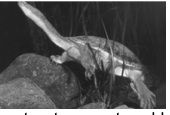
C. Rugosa
*wet dry tropics *aestivates in mud when swamps dry out Constructs a nest and lats eggs in anoxic mud at the bottom of the swamp in the wet season- only UNDERWATER nesting reptile *eggs diapause while underwater. when swamp dries out 02 increases as mud dries, rise in 02 breaks diapause and embryos begin to develop *in N Australia |
|
|
Broad shelled river turtle
|

C. Expansa
Lays eggs in autum/winter when soil temp is dropping (weird) *embryos begin to develop but enter a secondary diapause early in development *warming of soil in spring/summer breaks diapause and development continues *slow development- takes over a year in Victoria |

